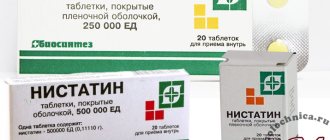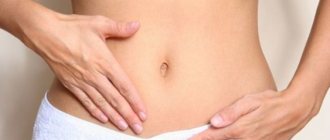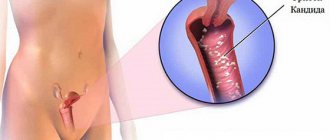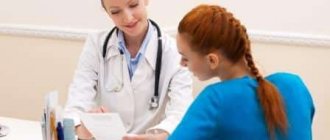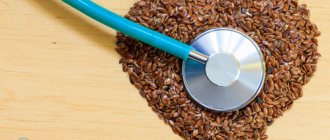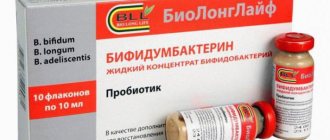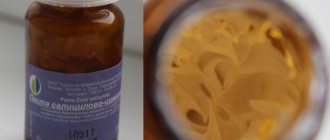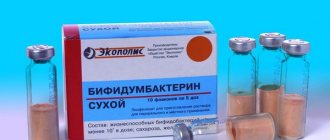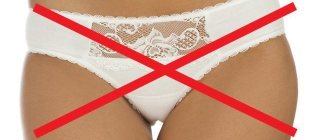Release form and composition
Bifidumbacterin suppositories (suppositories) are cylindrical in shape and white in color. The main active component of the drug is live bifidobacteria (Bifidobacterium bifidum), their content in one suppository is 10 million CFU (colony-forming units). Excipients are:
- Confectionery solid fat based on plasticized lard – 75-80%.
- Solid petroleum paraffin – 5-10%.
- Emulsifier T-2 5-10%.
Bifidumbacterin suppositories are packaged in blister packs in the amount of 10 pieces. One cardboard box contains one blister pack and instructions for use of the drug.
pharmachologic effect
Bifidumbacterin suppositories are a medicine that normalizes the microflora of the intestinal and vaginal mucosa with immunomodulatory properties. The bacteria that are part of the drug (Bifidobacterium bifidum) are representatives of the normal microflora of the intestinal and vaginal mucosa. Their main feature is the synthesis of lactic acid, which suppresses other microorganisms. When used, these bacteria colonize the surface of the mucous membrane and have an inhibitory effect on a number of pathogenic (pathogenic, including Shigella spp., Salmonella spp., Staphylococcus aureus) and opportunistic microorganisms (including Proteus spp., Klebsiella spp.). Also, bifidobacteria, being representatives of the normal microflora of the intestine and vagina, have a number of other positive effects:
- Bacterial colonies absorb (bind) toxins coming from the environment and formed on the mucous membrane.
- They increase the intensity of metabolic and redox processes.
- They regulate the acid-base state of the mucosal environment through the synthesis of lactic acid (normally, the mucosal environment should be slightly acidic).
- Activate local immunity on the mucous membranes.
- In the intestines they take part in the processes of parietal digestion and promote the digestion of plant fiber.
- In the course of life, they synthesize essential amino acids and vitamins (mostly B vitamins), which are necessary for the human body.
The main active component of the drug, when a suppository is inserted into the rectum or vagina, is not absorbed into the blood. Also, it is not eliminated from the body; under normal conditions, colonies of bifidobacteria form on the walls of the mucous membrane.
Bifidumbacterin
Bifidumbacterin is a unique remedy that I have been using for more than 5 years. Probably only milk mushroom would be better, and only because I make it myself.
Sold in the form of small transparent glass capsules and bottles that are hermetically sealed. Usually 12 pieces are packed in a cardboard box and there are instructions inside. The price of Bifidumbacterin is about 120-150 rubles. It is a little difficult to use, since you first need to open the capsule.
This is done with the help of a knife and ingenuity, if everything works out, then remove the rubber cap and fill the bottle with water, ordinary plain water, or from the tap. Shake Bifidumbacterin and drink. All the beneficial bacteria floated into your intestines. As you can see, the use of bifidumbacterin is easy.
The glass bottle contains beneficial lactobacilli in the hibernation stage, as soon as you fill them with water they come to life and begin to work actively.
Bifidumbacterin is usually used for stomach disorders, diarrhea, constipation, dysbacteriosis, during treatment with antibiotics, etc.
For prevention, you can drink 1 bottle of Bifidumbacterin per day. It’s better not to eat in the morning on an empty stomach for half an hour, but you can do it half an hour after eating.
For acute illness, take 2 vials 3 times a day. In the normal course of the disease, 1 bottle 3 times a day. The course is about 1 month, then there is usually a break and the course is again for one month. As a preventive measure, it is better to take a course of 1 month, 2 times a year. Bifidumbacterin is also often used to improve immunity in children and adults.
You can also use the drug to make yoghurts. For one liter of milk, put 1 bottle of Bifidumbacterin, leave for about 12 hours. Simply and easily!
Bifidumbacterin suppositories belong to the pharmacological group of eubiotic drugs. They contain live bifidobacteria and are used to normalize the microflora of mucous membranes.
Indications for use
Bifidumbacterin suppositories are used to restore normal microflora of the intestinal or vaginal mucosa in women with the following pathological conditions:
- Intestinal dysbiosis is a disruption of the normal microflora with a predominance of opportunistic bacteria; this condition develops for various reasons (long-term antibiotic therapy, previous intestinal infection, poor diet, stress, immunodeficiency).
- Chronic colitis is an inflammatory process in the mucous membrane of the large intestine.
- Dysbiosis (vaginosis) of the vagina in women is a disruption of the normal microflora of the mucous membrane.
- Nonspecific colpitis is an inflammatory pathology of the vaginal mucosa, most often caused by bacteria, representatives of a nonspecific infection (staphylococci, Proteus, E. coli).
- Hormonal colpitis is an inflammation of the vaginal mucosa in women against the background of disturbances in the level of sex hormones in the body, often accompanied by dysbiosis.
- Thrush (candidiasis) is a fungal infection of the intestinal or vaginal mucosa caused by opportunistic fungi of the genus Candida.
- As part of complex therapy for urogenital herpes, chlamydia and gonorrhea.
- Preparation for planned gynecological surgery or childbirth in women.
Sometimes this drug is used to prevent dysbiosis, especially if the body is exposed to various etiological causative factors of its development.
Causes of thrush recurrences
Thrush is an insidious disease; it is prone to constant relapses, even despite treatment. Many women suffer from the presence of cheesy white discharge, itching and burning in the vagina, not knowing what to do about it.
The first episode of candidal colpitis in most cases occurs in an acute form. It is simply impossible not to notice the profuse leucorrhoea, itching, and redness. But all these symptoms are quite easy to muffle by using at least one antifungal suppository or taking a pill. Most women do exactly this, taking a step towards chronic candidiasis. And after this, with the slightest decrease in protective forces or stress, thrush appears again, often not in such a bright form, but still bringing constant discomfort, refusal of intimacy, etc.
The problem lies in the following. No one is safe from candidal colpitis, since it is just a violation of the vaginal microflora. As soon as the number of Dederlein sticks is reduced by several orders of magnitude, the fungi already begin to multiply intensively, closing a vicious circle and leading to thrush. But it is always important to discover the reason why this happened, often it is taking some kind of medication, severe stress, sexually transmitted infection, constipation, etc.
Without eliminating the main provoking factor, a woman is at high risk of chronic candidiasis. At the same time, fungi, which normally can be found in the vagina, but in small quantities, constantly have favorable conditions for their reproduction, while colonies of lactic acid bacteria are reduced.
Thus, the main cause of chronic candidiasis is symptomatic treatment, which does not eliminate the factors that provoke new episodes of thrush.
We recommend reading the article about suppositories for thrush. From it you will learn about the treatment of the disease, effective suppositories for candidiasis, the action of Pimafucin, Terzhinan, Polygynax and other drugs.
What is the right thing to do if a woman has symptoms of the disease? It is recommended to do the following:
- There is no need to self-medicate; you should consult a specialist.
- It is imperative to complete the entire prescribed course, without ignoring the “last candle” or any individual drug.
- Before any therapy, it is advisable to do a bacteriological culture from the vagina. At the same time, it will be clear which flora prevails and to which drugs the fungi are most sensitive. The fact is that these microorganisms, like bacteria, have learned not to accept many drugs, showing resistance to them. If the treatment is prescribed empirically, the woman eventually arrives at the chronic process: the fungi that cause candidiasis in her no longer respond to any medications.
- It is also important to get tested for other sexually transmitted infections. They can occur hidden, however, if they are not cured, candidiasis will be a woman’s constant companion.
- If after the completed course of therapy the thrush recurs, the subsequent regimen should be taken more seriously. Treatment of chronic thrush continues for 3 to 6 months at intervals of taking tablets and suppositories. This is precisely the period required to completely restore the flora and restore the body’s defenses.
- It is advisable to treat the sexual partner, despite the fact that the role of this method of transmission is a very controversial issue today.
- Recurrent thrush is an indicator of dysbiosis not only in the vagina, but in the gastrointestinal tract, urinary system and other organs. Therefore, in order to radically recover, it is necessary to adjust the diet and restore the flora in all other parts of the body, especially the gastrointestinal tract. And bifidumbacterin after thrush or similar drugs help with this.
- The most important thing in preventing new episodes of candidal colpitis is eliminating provoking moments. Often these are hidden forms of diabetes, sexually transmitted infections, excessive use of fragrances in personal hygiene, etc.
Watch the video about thrush:
Directions for use and doses
Bifidumbacterin suppositories are administered into the rectal cavity (rectal administration) or into the vagina (intravaginal administration) 1 suppository 2-3 times a day. The duration of the course of therapy depends on the severity of changes in the microflora and averages 7-10 days. It is advisable to administer the suppository at regular intervals. The effectiveness of restoring normal intestinal or vaginal microflora is monitored by clinical improvement and laboratory bacteriological testing.
Tablets and other medications for the treatment of thrush in men
Therapy for candidiasis is not always successful due to the resistance of the pathogen to drugs. The disease often progresses to a permanent or complicated stage.
Instructions for use of Bifidumbacterin for thrush: one suppository intravaginally twice a day for five to ten days.
This is how to use suppositories during pregnancy: 1 suppository twice a day for 10 days under the supervision of a specialist.
A solution of Bifidumbacterin for candidiasis is used as follows: a tampon, generously soaked in the medicine, is administered intravaginally for two to three hours.
The composition should be prepared as follows:
- 5-10 doses of powder;
- 15-20 ml of boiled water.
The duration of the therapeutic course is from eight to ten days.
If necessary, this treatment for thrush in women is repeated after three to four months.
The drug is sold in pharmacies without a prescription.
So, Bifidumbacterin is an effective remedy, produced in different forms (powder, ampoules, tablets, suppositories), which is actively used for the treatment of candidiasis.
The main advantages of the drug are its safety and the possibility of use during pregnancy (lactation). Bifidumbacterin can be purchased at any pharmacy without a prescription.
Side effects
When Bifidumbacterin suppositories are introduced into the rectal cavity or vagina, an allergic reaction may develop, which is manifested by a rash on the skin, itching, and the development of urticaria (a characteristic rash and swelling, similar in appearance to a nettle burn). Cases of severe allergic reactions in the form of angioedema (severe swelling of the skin and subcutaneous tissue with predominant localization in the face and external genitalia) and anaphylactic shock (a progressive decrease in blood pressure and multiple organ failure) have not been reported.
Structure of the biocenosis of the vagina of healthy women
More than 40 types of microbes.
Lactobacillus dominates - 90-97% (more than 170 species are known, in the vagina - more than 20 species).
The remaining 3-10%:
- L. crispatus (normally dominates, with bacterial vaginosis it tends to zero);
- L. Iners (with bacterial vaginosis it decreases, unlike thrush, but not significantly);
- L. jensenii;
- L. gasseri;
- L. vaginalis.
- Gardnerella vaginalis;
- Atopobium vaginalis;
- Mycoplasma hominis;
- Clostridiales;
- Prevotella;
- Leptotrichia;
- Candida and many others.
- Lactobacillus
Many studies have shown that the commonly used lactobacilli in probiotics (L. acidofilus, L. rhamnosus, L. Reuteri) are not found at all or are extremely rare in the normal vaginal biocenosis, so it is important to replace them with commonly found lactobacilli. L. crispatus is isolated up to 90%, so its use is most preferable.
Lactobacilli (lactobacillus, Doderlein bacilli) provide natural acidification of the environment, the production of hydrogen peroxide, thereby preventing pathogens from multiplying and developing, protecting the vagina. They are observed in healthy women in 70-100% of cases.
Acidic environments in the body are important for humans and are intended to create a biological shield against the invasion of infectious agents. Normally, acidification of the vaginal environment occurs with the help of lactobacilli.
The following are used as lactic bacteria donors:
- Prebiotics (fruit ooligosaccharides) are nutrients that support the growth of lactobacilli and help restore vaginal microflora in the most natural way, namely by feeding beneficial symbionts.
- Eubiotics (Gynoflor E-viable lactobacilli to restore vaginal microflora and microdoses of estriol to create conditions for the vital activity of lactobacilli, reduces the incidence of recurrent vaginal infections after anti-infective therapy by 1.5 times).
- Probiotics are live microorganisms that are beneficial symbionts (neighbors) for the host organism. They displace pathogenic microorganisms and are able to form an immune response. Studies have found that intravaginal use of probiotics after treatment of genital candidiasis reduces women's return to the doctor after treatment and successfully prevents relapses within 6 months.
special instructions
Before you start using Bifidumbacterin suppositories, you must carefully read the instructions; you should pay attention to several special instructions, which include:
- The drug can be used in combination with other drugs, as it does not interact with them.
- The combined use of antibiotics can inhibit the growth and colonization processes of bifidobacteria in the mucous membrane.
- B vitamins stimulate the growth and reproduction of bifidobacteria, therefore enhancing the therapeutic effect of using Bifidumbacterin suppositories.
- The drug can be used for pregnant, lactating women and children.
- Bifidumbacterin suppositories do not affect concentration and speed of psychomotor reactions.
The drug is sold in pharmacies without a doctor's prescription. If you have any questions or doubts regarding its use, you should consult your doctor.
Contraindications
Bifidobacteria themselves do not cause harm to the body. However, there are a number of restrictions on taking Bifidumbacterin:
- For any disorders of carbohydrate metabolism (lactase deficiency, diabetes mellitus, lactose, fructose and sucrose intolerance, malabsorption syndrome), the drug is not allowed to be taken orally.
- Vaginal forms are contraindicated for injuries of the vagina and perineum.
- For thrush in girls, the drug is used only orally; vaginal forms are prohibited.
The drug can cause a number of side effects: nausea, rumbling in the stomach and diarrhea when taken orally. When used vaginally, itching, burning, and discharge may occur. Such reactions occur rarely and indicate intolerance to additional substances. Overdose phenomena have not been described.

